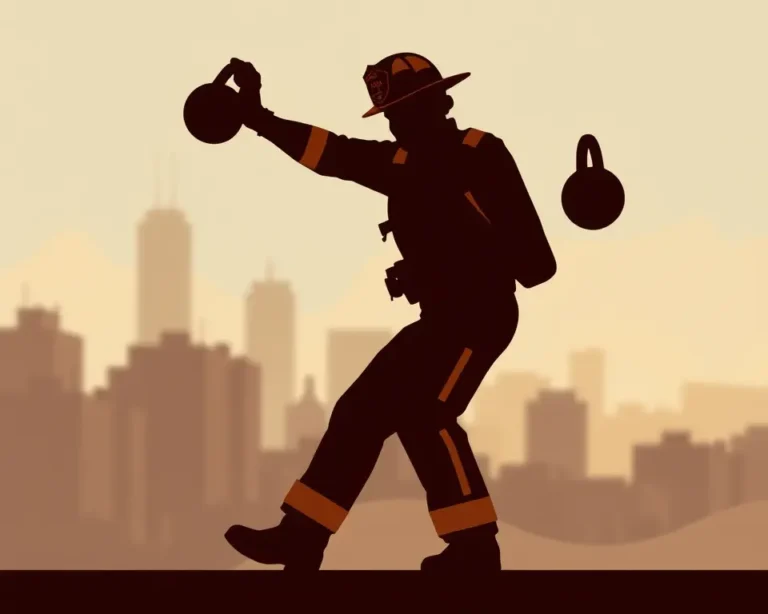First responders – firefighters, police officers, and paramedics – face extreme physical and mental demands daily. Functional fitness offers a targeted approach to prepare them for these challenges, enhancing their ability to perform their duties effectively and safely. By focusing on real-world movements and conditioning, this training philosophy builds a foundation of strength, endurance, and resilience, vital for those who protect and serve.
Understanding Functional Fitness for First Responders
Functional fitness trains the body for activities performed in daily life. For first responders, this translates to exercises that mimic the actions they encounter on the job: crawling, lifting, carrying, dragging, climbing, balancing, and twisting. Unlike traditional bodybuilding, which isolates muscle groups, functional fitness emphasizes compound movements that engage multiple muscle groups simultaneously.
The “Big Eight” of Functional Fitness
For firefighters, tacticaltrainingandconditioning.com highlights “The Big Eight” which are push, pull, carry, lift, drag, core, capacity, and flexibility. Addressing these elements ensures well-rounded preparedness for the diverse physical challenges faced on the fireground.
Why Functional Fitness Matters
- Enhanced Performance: Functional fitness directly translates to improved performance in real-world scenarios. It equips first responders with the strength and stamina to handle demanding tasks, such as rescuing victims, carrying heavy equipment, and performing prolonged operations.
- Injury Prevention: By strengthening stabilizing muscles and promoting proper movement patterns, functional fitness reduces the risk of injuries. This is especially crucial for first responders, who are prone to musculoskeletal disorders due to the nature of their work.
- Improved Mobility and Flexibility: Functional fitness incorporates exercises that enhance flexibility and range of motion. This allows first responders to move more efficiently and safely, reducing the risk of strains and sprains.
- Increased Core Strength: A strong core is essential for stability, balance, and power. Functional fitness emphasizes core engagement in nearly every exercise, providing a solid foundation for all movements.
- Mental Resilience: Physical fitness is intrinsically linked to mental well-being. Exercise reduces stress, improves mood, and enhances cognitive function, enabling first responders to better cope with the psychological demands of their jobs.
Designing a Functional Fitness Program
A well-designed functional fitness program should incorporate a variety of exercises that target different aspects of physical fitness. Here are key components to consider:
1. Foundational Movements
These movements form the basis of a functional fitness program and build a strong foundation for more advanced exercises. Examples include:
- Squats: Strengthen the legs and glutes, essential for lifting and carrying.
- Deadlifts: Develop overall strength and power, crucial for lifting heavy objects.
- Push-ups: Build upper body strength and endurance for pushing and pressing movements.
- Pull-ups: Improve upper body strength for climbing and pulling actions.
- Lunges: Enhance lower body strength, balance, and stability.
2. Carry Exercises
First responders routinely carry heavy objects, so incorporating carry exercises into a fitness program is essential.
- Farmer’s Walks: Improve grip strength, posture, and core stability.
- Sandbag Carries: Challenge strength and endurance while simulating uneven loads.
- Fire Hose Drags: Mimic the demands of dragging heavy hoses at fire scenes.
3. Core Strengthening Exercises
A strong core is vital for stability and injury prevention.
- Planks: Improve core stability and endurance.
- Russian Twists: Enhance rotational core strength.
- Medicine Ball Slams: Develop explosive core power.
- Bird-dog: Improves core strength and balance.
4. Mobility and Flexibility Exercises
Mobility and flexibility exercises are often overlooked, but are essential for preventing injuries and improving performance.
- Foam Rolling: Alleviate muscle tension and improve flexibility.
- Dynamic Stretching: Prepare the body for activity by increasing range of motion.
- Yoga and Pilates: Enhance flexibility, balance, and core strength.
5. High-Intensity Interval Training (HIIT)
HIIT involves short bursts of intense exercise followed by brief recovery periods. It’s an effective way to improve cardiovascular fitness and burn calories.
- Sprints: Improve speed and power.
- Burpees: A full-body exercise that combines strength and cardio.
- Battle Ropes: Develop upper body strength and endurance.
- Stair Climbing: Simulates climbing stairs with heavy gear.
Sample Functional Fitness Workouts
Here are a few sample workouts that can be adapted to different fitness levels:
Workout 1: Strength and Conditioning
- Warm-up: 5 minutes of dynamic stretching (arm circles, leg swings, torso twists)
- Workout:
- Squats: 3 sets of 10-12 repetitions
- Push-ups: 3 sets to failure
- Deadlifts: 1 set of 5 repetitions, 1 set of 3 repetitions, 1 set of 1 repetition
- Farmer’s Walks: 3 sets of 50-yard carries
- Plank: 3 sets, holding for 30-60 seconds
- Cool-down: 5 minutes of static stretching (holding stretches for 30 seconds)
Workout 2: Cardio and Core
- Warm-up: 5 minutes of light cardio (jogging, jumping jacks)
- Workout:
- HIIT Sprints: 8 rounds of 30-second sprints with 30-second rest
- Medicine Ball Slams: 3 sets of 15-20 repetitions
- Russian Twists: 3 sets of 15-20 repetitions per side
- Burpees: 3 sets of 10-15 repetitions
- Foam Rolling: 10 minutes, targeting major muscle groups
- Cool-down: 5 minutes of static stretching
Workout 3: Firefighter Fitness Circuit
- Warm-up: Hydrate, stretch and warm up as preferred.
- Workout: Perform each station for 45 seconds, followed by 15 seconds of rest. Repeat the circuit 3-5 times.
- Battle rope arm exercise using a 50-foot length of 2.5-inch hose
- Kettlebell Swings
- Box Jumps
- Pull-ups
- Sled drags
Nutrition for Optimal Performance
Nutrition plays a vital role in supporting functional fitness and overall health for first responders. A well-balanced diet provides the energy and nutrients needed to perform demanding tasks, recover from strenuous activity, and maintain optimal health.
Key Nutritional Considerations
- Macronutrient Balance: Consume a balance of protein, carbohydrates, and healthy fats.
- Protein: Essential for muscle repair and growth. Good sources include lean meats, poultry, fish, beans, and tofu.
- Carbohydrates: Provide sustained energy. Choose complex carbohydrates like whole grains, fruits, and vegetables.
- Healthy Fats: Support brain function and satiety. Include sources like avocados, nuts, and olive oil.
- Hydration: Drink plenty of water throughout the day, especially during and after shifts.
- Regular Meals: Prioritize regular meals to maintain stable energy levels. Pack nutrient-rich meals and snacks to avoid unhealthy options.
- Smart Snacking: Choose healthy snacks like fruits, vegetables, nuts, and yogurt to prevent energy crashes.
- Limit Processed Foods: Reduce intake of sugary drinks, fast food, and processed snacks.
- Consider Supplements: Daily multivitamins, vitamin C, D3, and B12 supplements can be beneficial for strengthening the immune system and elevating energy levels.
Mental Wellness: An Integrated Approach
The demanding nature of first responder work can take a toll on mental health. Integrating mental wellness strategies into a functional fitness program is crucial for overall well-being.
Strategies for Mental Wellness
- Exercise as Therapy: Physical workouts provide an outlet for stress, anger, and frustration.
- Mindfulness and Meditation: Practice mindfulness techniques to reduce stress and improve focus.
- Adequate Sleep: Prioritize sleep to allow the body and mind to recover.
- Social Support: Maintain strong social connections with family, friends, and colleagues.
- Professional Help: Seek professional help if you are struggling with stress, anxiety, or PTSD.
Overcoming Challenges
Implementing a functional fitness program for first responders can present challenges. Shift work, long hours, and limited access to facilities can make it difficult to maintain a consistent routine.
Tips for Success
- Start Small: Begin with simple exercises and gradually increase intensity and duration.
- Find a Workout Buddy: Exercising with a partner can provide motivation and accountability.
- Utilize On-Shift Time: Incorporate short workouts or mobility exercises during breaks.
- Create a Home Gym: Invest in basic equipment for home workouts.
- Prioritize Recovery: Allow adequate time for rest and recovery to prevent injuries.
Conclusion: A Healthier, Stronger, More Resilient Force
Functional fitness is more than just a workout; it’s a comprehensive approach to enhancing the health, performance, and resilience of first responders. By focusing on real-world movements, proper nutrition, and mental wellness, this training philosophy equips these heroes with the tools they need to thrive in their demanding roles. Embracing functional fitness is an investment in a healthier, stronger, and more resilient first responder force, ready to protect and serve our communities with unwavering dedication.







